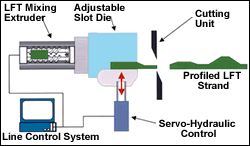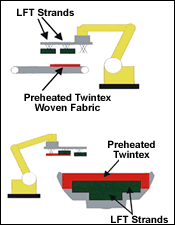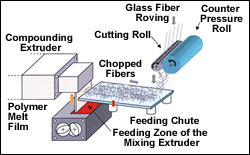D-LFT Composites Aim for Auto Body Panels
Direct long-fiber thermoplastic (D-LFT) compounding and molding is getting ready to expand beyond non-appearance structural automotive parts to exterior body panels.
Direct long-fiber thermoplastic (D-LFT) compounding and molding is getting ready to expand beyond non-appearance structural automotive parts to exterior body panels. The move also involves a switch from polyolefins, which have been the mainstay of D-LFT composites, to styrenic thermoplastics. Compression molding of large thermoplastic composite body panels reportedly has passed its first successful feasibility study. The road appears to be open to evaluation of rear hatches, doors, and roofs with Class A surfaces.
In the meantime, there are also new developments in structural D-LFT auto parts for chassis and under-hood applications. These include profiling blank thickness with an adjustable die, adding reinforcing fabrics to random chopped-glass blanks, and investigating nylon as a D-LFT matrix under the hood.
Classy finish
Tests of large D-LFT body panels started with both injection and compression molding, and both types passed impact tests, says Frank Henning, director of polymer engineering at the Fraunhofer Institute for Chemical Technology in Germany. "The compression molded parts showed more than 50% higher impact resistance than the injection molded ones, and compression molding would likely be the method of choice for large parts anyway," he notes.
One advantage for compression molding of large D-LFT parts is the ease of inserting reinforcing fabrics or decorative surface films into the tool. The material also doesn't flow as far in compression molding, resulting in less fiber orientation and less warpage.
Compression molding trials of large D-LFT body panels began two years ago and are ongoing at Dieffenbacher GmbH in Germany, working with the Fraunhofer Institute and BASF AG. BASF spent five years developing new materials and dry-paint films (together with an unnamed film producer) for these applications.
Dieffenbacher's newest development in D-LFT for Class A finish is chopped-fiber feeding. Dieffenbacher's typical approach to D-LFT is to pull continuous glass roving into a twin-screw extruder where the screws cut the rovings and blend them gently into premelted polymer. But exterior body panels require better fiber dispersion to avoid print-through at the surface of the Class A parts. So now the fibers are chopped dry and dropped onto a feeding cute, which meters them into a curtain of melt extruded from a slit die. That falling curtain of melt carries the fibers into a second extruder for mixing. This opens up the fiber bundles, so there is better dispersion of individual filaments, says Fraunhofer's Henning.
New materials arrive
Test parts for exterior body panels also required new materials, in particular thermoformable PFM (paintless film molding) skins, specially developed by BASF. PFM skins can be pigmented, textured, or grained so as to eliminate the need for secondary finishing.
PFM skins are thermoformed and then backmolded with 20% to 30% glass-reinforced ABS or SAN, using resins developed by BASF for these applications. Styrenic materials are used for both the PFM films and backing composite because exterior body panels are likely to be assembled together with steel parts, and styrenics have a lower thermal expansion coefficient than many other thermoplastics. Cycle times for molding these panels with PFM skins are 30 to 40 sec, compared with 60 sec for comparable thermoset SMC parts, says Heinrich Ernst, Dieffenbacher's head of sales.
D-LFT body panels are being considered for a replacement part for 2005 model cars and original parts for 2006 and 2007 models. "The first step will be roof modules," says Herbert Fisch, BASF's automotive business manager.
The first D-LFT exterior appearance part to hit the road—at the end of 2005—will not use a decorative film and will not be Class A. It will have a stippled grain surface and will be molded of glass-filled PP. It will appear on the lower section of a rear hatch of a European car.
Profiled blank thickness
For structural D-LFT parts, Dieffenbacher developed a die with an adjustable orifice that permits profiling selective thick and thin spots into sheet blanks so as to maximize strength in particular areas while minimizing overall material usage. (This is an approach also being used by other suppliers of D-LFT technology.) Dieffenbacher's adjustable die uses a servo-hydraulic cylinder on the lower lip with a sensor to indicate opening width.
The Dieffenbacher die varies thickness from 2 to more than 30 mm, though the range for most test parts is 5 to 15 mm. Profiled sheet blanks require less compression force to distribute material in the tool. Since the extruder runs at a constant speed, a thin sheet comes out faster, while a thick one comes out more slowly. Computerized line controls match the speed of the take-off conveyors to the sheet thickness. Blanks are cut with a twin-blade cutter between two belts. The second belt shuttles sideways, so blanks can be profiled for two different molds.
Local reinforcing fabric
Also for structural parts, Dieffenbacher and the Fraunhofer Institute developed an automated process using robots and needle grippers to insert woven and nonwoven fiberglass reinforcements in specific locations in a part. The BMW front-end panel that won a JEC Composites show award in 2002 was the first demonstration of thermoplastic compression molding with local continuous-fiber reinforcement. It uses a long strip of Twintex woven PP/glass fabric from Saint-Gobain Vetrotex. Twintex with 60% glass is placed along the upper load-bearing edge of the part and non-woven glass strands are used on a ribbed area. Twintex inserts are pre-warmed in an infrared heater before being stacked on top of the D-LFT blanks.
Dieffenbacher and the Fraunhofer Institute plan to conduct a feasibility study on combining Twintex reinforcement with a PFM cosmetic film. The film will be placed first into the mold, followed by the D-LFT composite blank and then the Twintex fabric.
What's more, nylon 66 D-LFT is being considered by at least one European car maker for heat-resistant parts to replace SMC in the engine compartment.
Related Content
The Effects of Stress on Polymers
Previously we have discussed the effects of temperature and time on the long-term behavior of polymers. Now let's take a look at stress.
Read MorePrices of All Five Commodity Plastics On the Way Up
Despite earlier anticipated rollover in prices for most of the volume commodity resins, prices were generally on the way up for all going into the third month of first quarter.
Read MorePart 3: The World of Molding Thermosets
Thermosets were the prevalent material in the early history of plastics, but were soon overtaken by thermoplastics in injection molding applications.
Read MorePrices Up for All Volume Resins
First quarter was ending up with upward pricing, primarily due to higher feedstock costs and not supply/demand fundamentals.
Read MoreRead Next
Lead the Conversation, Change the Conversation
Coverage of single-use plastics can be both misleading and demoralizing. Here are 10 tips for changing the perception of the plastics industry at your company and in your community.
Read MoreBeyond Prototypes: 8 Ways the Plastics Industry Is Using 3D Printing
Plastics processors are finding applications for 3D printing around the plant and across the supply chain. Here are 8 examples to look for at NPE2024.
Read More






















